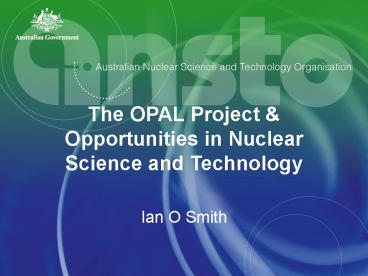The OPAL Project PowerPoint PPT Presentation
Title: The OPAL Project
1
The OPAL Project Opportunities in Nuclear
Science and Technology
Ian O Smith
2
Timeline for OPAL Development
- 1997
- In-principle approval for multipurpose reactor
- 1997-98
- Parliamentary processes and EIS approval
- 1998-2000
- Tendering and tender evaluation
- July 2000
- Contract awarded to INVAP SE
3
Timeline Continued
- April 2002
- ARPANSA issues construction licence
- September 2005
- Final submission for Operating licence
- July 14 2006
- ARPANSA grants operating licence
- August 12 2006
- First criticality
4
(No Transcript)
5
(No Transcript)
6
(No Transcript)
7
(No Transcript)
8
(No Transcript)
9
(No Transcript)
10
(No Transcript)
11
Purpose of OPAL
- Maintenance of nuclear technical expertise
- Nuclear medicine support
- Neutron Beam Research Facility
- Research and Training
- Irradiation facility for NAA TDSi
12
Neutron Beam Instruments
13
(No Transcript)
14
Indicative Demand
15
(No Transcript)
16
Some Examples of Neutron Beam Research Projects
- ILL Grenoble France
- NIST Washington USA
17
Cartoon of Typical Cell Membrane
18
Membrane Proteins
19
Biomimetic surfaces used for sensing and drug
screening
20
Obesity Research at ILL
21
HIV Virus Research at ILL
22
Thermally Tolerant Proteins at ILL
23
Muscle Control Research at ILL
24
Structural Studies of Cellulose at ILL
25
Hydrogen Storage Research at NIST
This computer model shows how titanium atoms
(dark blue) can attach above the centres of
single-walled carbon nanotubes (light blue).
Quantum calculations and modelling by a NIST
researcher and his colleague reveal that each
titanium atom can bond with four hydrogen
molecules (red), a finding that could lead to
efficient fuel cells for future automobiles.
Image Credit T. Yildirim/NIST
26
Residual Stress Analysis Determinations at NIST
27
I hope you enjoy your visit to ANSTO at Lucas
Heights on Friday
- Thank You
PowerShow.com is a leading presentation sharing website. It has millions of presentations already uploaded and available with 1,000s more being uploaded by its users every day. Whatever your area of interest, here you’ll be able to find and view presentations you’ll love and possibly download. And, best of all, it is completely free and easy to use.
You might even have a presentation you’d like to share with others. If so, just upload it to PowerShow.com. We’ll convert it to an HTML5 slideshow that includes all the media types you’ve already added: audio, video, music, pictures, animations and transition effects. Then you can share it with your target audience as well as PowerShow.com’s millions of monthly visitors. And, again, it’s all free.
About the Developers
PowerShow.com is brought to you by CrystalGraphics, the award-winning developer and market-leading publisher of rich-media enhancement products for presentations. Our product offerings include millions of PowerPoint templates, diagrams, animated 3D characters and more.

